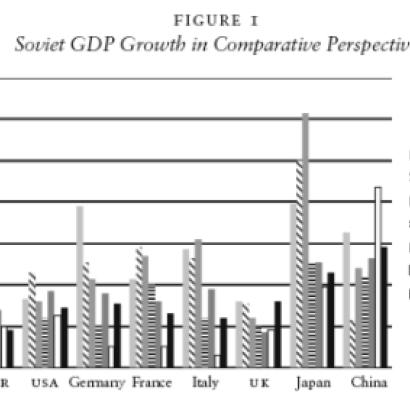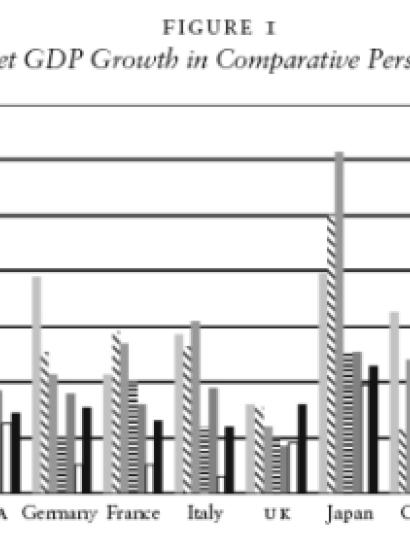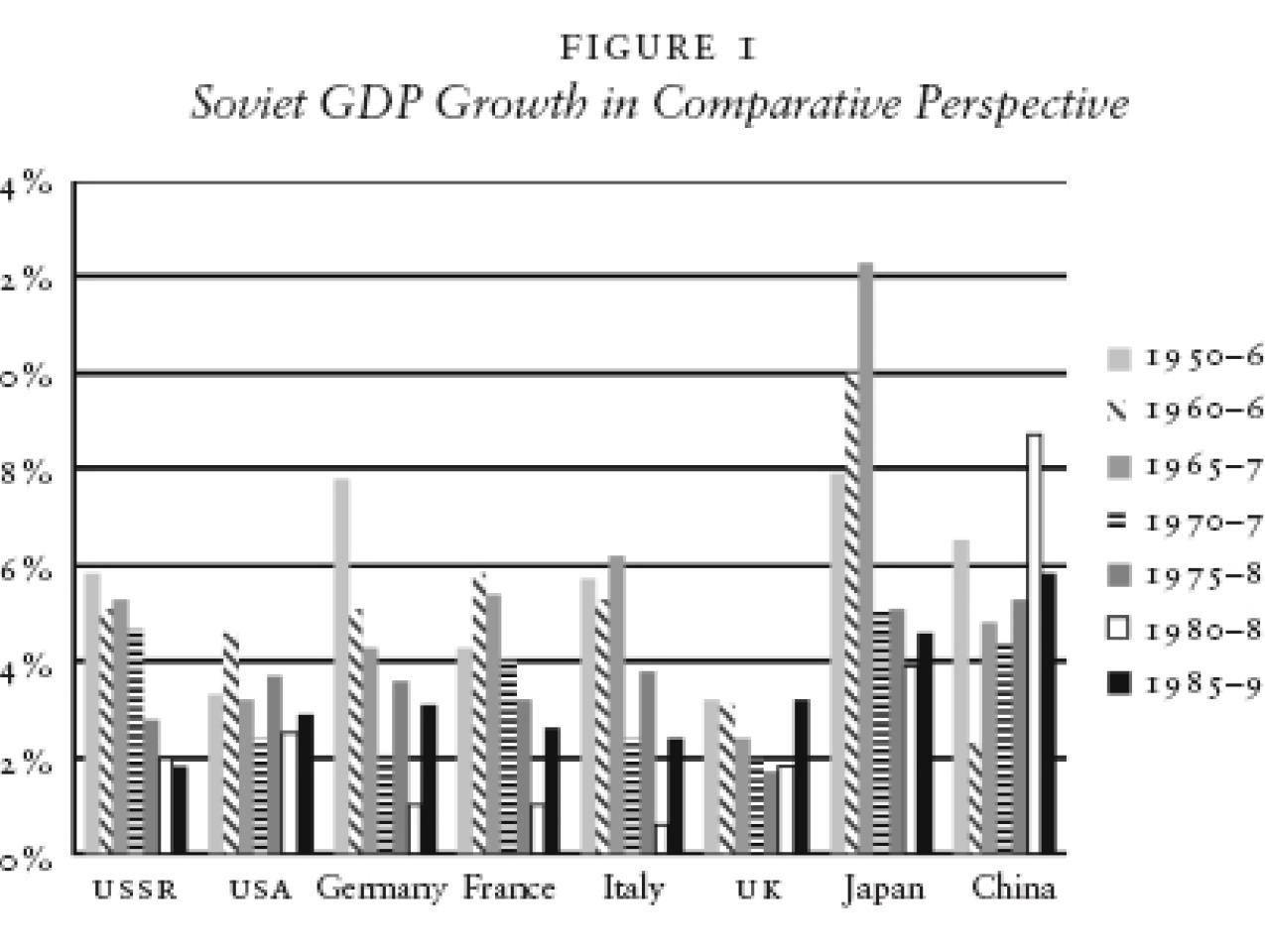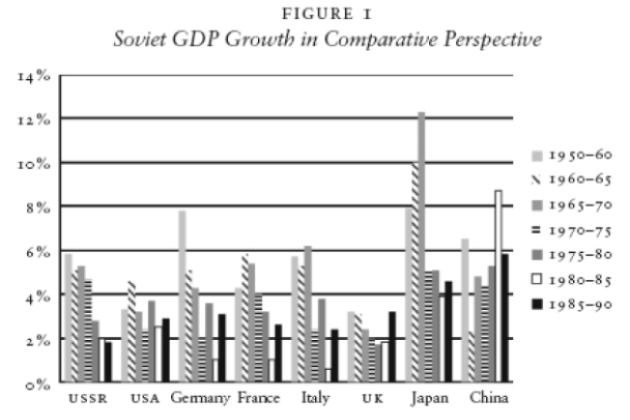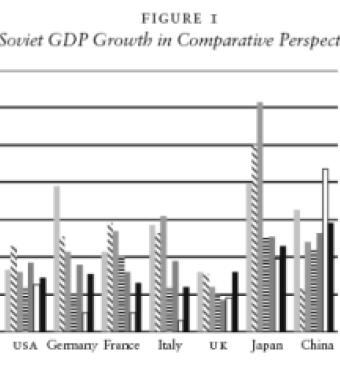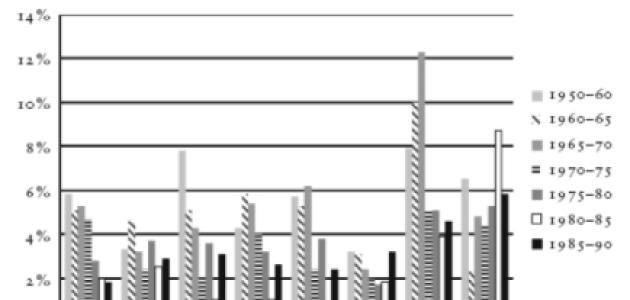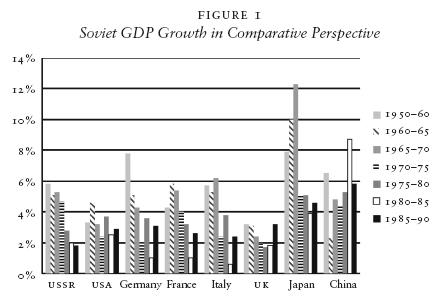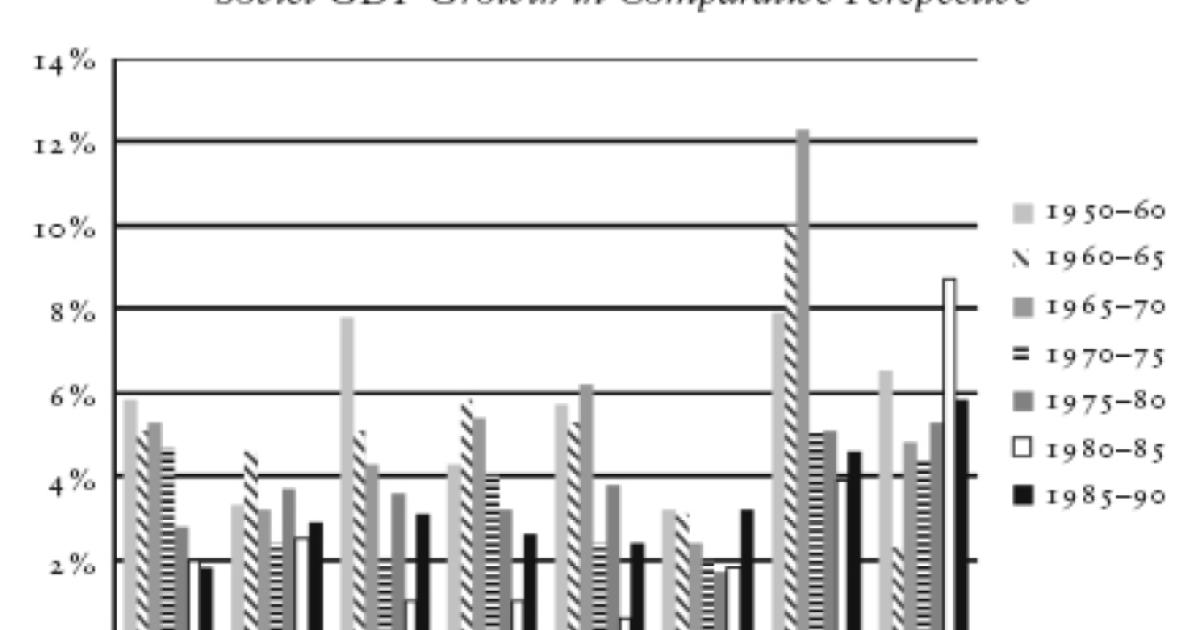The soviet flag was lowered from atop the Kremlin on December 25, 1991. It is doubtful this event will ever be memorialized in Russia, whose current prime minister characterizes it as the “greatest political disaster of the twentieth century.” The political end of the ussr was the final step in the destruction of the Soviet system. The nail in the coffin of its primary pillar dates three years earlier, to September 1988, as Mikhail Gorbachev disbanded the industrial-branch departments of the central Committee, the last vestiges of central control. Fall 2008 marks the twentieth anniversary of the end of the Soviet administrative-command system. As the most significant experiment of the twentieth century, it is appropriate to perform a post mortem on it, armed with memoirs, interviews, and open archives.
The collapse of the Soviet system was a rare event in human history. Regimes, administrations, and governments come and go regularly, but there are no precedents for a comprehensive socio-political-economic system to disappear quickly and with little warning after 50 years of existence. Economic systems change throughout their history, but they usually evolve gradually through hundreds of thousands of Hayekian human actions. Only in rare cases, where human design dominates, are changes visible to the human eye (such as the creation of the European Union or peace settlements after wars). The Soviet system was created by human design, and its collapse was also engineered by human design. This explains the speed of collapse and why we are more likely to make sense of it despite its recent vintage.
In this essay, I attempt to explain why the Soviet system collapsed, and its timing. I use a simple model that synthesizes a number of models:1 It assumes that an elite of “system electors” (the Soviet nomenklatura, the Central Committee, or some other authoritative grouping) periodically decides whether to continue the status quo (the administrative command system) or “defect” to an “outside option” (replacement of the administrative command system with another system). The choices may be represented by different leaders, such as a choice between Leon Trotsky and Josef Stalin or Mikhail Gorbachev and Yegor Ligachev for the party leadership, or between organized groups, such as the military-industrial complex versus agricultural interests. Elite “electors” use cost-benefit analysis to assess whether they are better off with the status quo or the outside option. If there is sufficient support for the outside option, system change will occur.
In defining my task, I must be careful to state what I am trying to explain. The collapse of the economic system differs in substance and in timing from the collapse of the ussr, the Soviet bloc, or the “leading role” of the communist party. The Soviet administrative-command system ended when its three pillars — administrative resource allocation by industrial ministries, property rights vested in the Soviet state, and direction of economic activity by a monopoly party — collapsed. The ministerial resource allocation began to crumble with the anti-bureaucracy campaign of May 1986 and culminated with the implementation of the enterprise law of June 1987. The communist party’s direction of economic activity ended in September 1988 with the abolition of the sectoral departments of the Central Committee. The de facto transfer of property rights from the Soviet state was more gradual. The November 1986 law on individual labor activity and the March 1988 law on cooperatives lifted restrictions on earnings, and the March 1989 law on leasing promoted the transfer of state assets to individuals.2
My task, therefore, is to explain why the administrative-command system was destroyed and why it was destroyed when it was. Notice that I have not yet defined the “outside option.” The outside-option choices ranged from an economic system designed to maximize rent-seeking and corruption, to a Chinese-like market socialism, to an economic system of transparency, secure property rights, and a rule of law. The outside option selected was, unfortunately, much closer to the first than the third.
The durability of the
administrative-command system
Presumably, soviet leaders could have selected the “outside option” earlier. The power struggle of the 1920s could have ended with a nep-like mixed economy. At the end of World War II, Stalin could have opted not to restore the party to power. Stalin’s successors could have decided in favor of deep economic reforms shortly after his death. Nikita Khrushchev, with all his harebrained schemes, could have tried more radical reform.
Although the administrative-command system was assembled in great haste and by trial and error, it proved notably resistant to change. From 1930 to 1985, Soviet “system electors” chose the status quo, while periodically flirting with cosmetic reforms. Reform by reshuffling of the administrative structure began in 1930; a succession of reshufflings, from the breaking up of the “super industrial ministry” into an ever larger number of ministries in the 1930s to the creation of a “super agricultural ministry” by Gorbachev early in his tenure, failed to yield improvements. Attempts to make the planning system more “scientific” also failed from the early 1930s onwards. The most “radical” reform — to allow enterprises to make more of their own decisions — had already been proposed in 1931 by the influential minister of heavy industry.3 These very same ideas resurfaced in 1961 as the Liberman reforms, to be tried in part and then rejected in the Kosygin reform of 1965. These same reform principles formed the core of Gorbachev’s initial perestroika proposals after 1985.
The distinction between “reform” and “transition” should be emphasized to avoid unnecessary confusion. “Reforms” are changes designed to improve the existing system without sacrificing its fundamental features. “Transition” is the movement from the administrative-command system to an outside option, such as a market economy. Throughout the history of the Soviet reform movement, no one other than fringe academics advocated transition. Gorbachev resisted the concept of transition to the very end, declaring even after the failed August 1991coup: “I am convinced that socialism is correct.”4 It was his rival Boris Yeltsin who first advocated transition to a market economy and then proceeded to vacillate on this decision throughout his term. From Stalin through Chernenko, the status quo was protected to such an extent that attempts at more than cosmetic reform were resisted with ferocity.
Constituency for change
According to my model, the administrative-command system remains resistant to change as long as the “elector” constituency favors the status quo. The fact that the administrative-command system remained remarkably unchanged from 1930 to 1985 tells us that the “outside option” constituency was weak. During the Stalin era, the status quo was by definition infallible; failures were due to human error or deliberate sabotage under Stalin’s “cadres decide all” motto. It would have been fatal to argue otherwise.
The status quo and outside option constituencies remained basically the same from 1931 on, although it should be emphasized that the latter advocated reform, not transition. The Soviet elite appointed to state and party positions through nomenklatura appointments (hence: the nomenklatura) were basically divided between “planners” who issued instructions and intervened in the production process and “producers” held responsible for carrying out the orders and interventions of the first group.5 “Planners” included national and regional party leaders, council of ministers members, and planning and finance officials. “Producers” included enterprise managers and regional officials in charge of local enterprises. Industrial ministries stood at the intersection of producers and planners, with both held responsible for results and issuing instructions to enterprise managers.
Responsibility for final results defined the difference between producers and planners. Producers complained that superiors gave orders but bore no responsibility. Minister of Heavy Industry G.K. Ordzhonikidze (in an outburst in a Politburo meeting of August 1931): “You want to play the role of bureaucrat, but when my factories fall apart, it is I who must answer not those of you who engage in such ‘serious discussions’ here.”6 The deputy chairman of a military industrial plant echoed these sentiments some 50 years later: “They [the defense branch department of the central committee] would inquire why the plan isn’t being fulfilled, they acted like they were another Council of Ministers. But they had more authority and none of the responsibilities.”7
From 1931 on, “producers” argued for increased freedom and reduced “petty tutelage.” “Planners” argued that producers must be kept under control by coercive means because they otherwise produced too little, demanded too much, charged too high prices, and skimped on quality. Producers were held responsible, plagued by ill-conceived plans and by moving targets. The producers’ lament remained the same. Ordzhonikidze (1931): “From the decrees that are being received I guess the impression is that we are idiots. They give us every day decree upon decree, each successive one is stronger than the previous and without foundation.”8 A chief defense contractor (speaking more than 50 years later) echoed Ordzhonikidze: “They would stick their heads into every single issue. They would say: ‘This must be so.’ We told them they were wrong, but they would demand that things be done they way they said it should be done.”9
Both sides had valid arguments. Producers, if left to their own devices, would under-produce and over-demand resources, as the planners said. For their part, producers could point to stupid, contradictory, and changing orders and excessive meddling that prevented them from running their enterprises efficiently.
The stalemate persisted for more than a half century, for good reason. A state-owned enterprise left to its own devices would operate like a vehicle without a steering wheel. It would be owned “by everyone and hence by no one.” There were no markets in which to buy inputs and sell outputs. There were no scarcity prices to indicate what was cheap and what was expensive. In fact, theory suggests that an administrative-command system would collapse upon itself if administrative coercion were removed.10
The Soviet Union, in fact, had a preview of the effect of reduced administrative coercion. When planning targets were deliberately moderated in 1976 to encourage managers to use their resources more efficiently, output growth contracted but the efficiency of resource use did not improve.11
The Perestroika coalition
Michael ellman and Vladimir Kontorovich, in their exhaustive study of the events leading up to the collapse, conclude that the Soviet nomenklatura was not a reform constituency: “We find no evidence that the Soviet system was toppled by the party and state officials in order to turn their power into private wealth.”12 Rather, they attribute the post-reform success of the nomenklatura to “individual survival skills rather than some grand design.” If Ellman and Kontorovich are to be believed, those who were to benefit from the toppling of the system played no role in its collapse. Instead they were simply handed new opportunities on a silver platter without any effort on their part.
The conclusion that those who were to benefit from the system’s end did not coalesce to further its collapse requires a conspicuous lack of foresight. It seems safer to assume that the nomenklatura would have used rational expectations to fathom that they could prosper under the outside option — a conclusion that would mobilize them into a potent constituency for the outside option. Indeed, the collapse of the administrative-command system created substantial wealth for the winners, who were drawn primarily from nomenklatura appointees. “After the end of mass privatization, former nomenklatura appointees accounted for about two thirds of the top positions in Russian business and government.”13
Valery Lazarev has used the behavior of party members in the period leading up to the collapse as a barometer of confidence in the status quo. He notes that under the administrative-command system membership in and advancement in the party offered opportunities to earn economic rents in the form of higher salaries and perks. Young people entered the party as candidate-members and had to put in years of service before a portion of them advanced to rent-seeking positions. The decision to join the party was, therefore, based on long-run considerations, such as the probability of advancement and the size of the economic rent to be earned upon advancement. Young activists compared these expected lifetime rents with their outside options, such as employment outside the party.
According to Lazarev’s logic, the number of young persons joining the party as “candidates” provides a measure of expectations of the value of a party career. In the post-Stalin period, the number of candidates was characterized by stable low numbers and a declining trend. But in the years immediately preceding the end of the Soviet regime, the number of new candidates approached zero. Although expected rents from party positions did not fall (as measured relative to average earnings), they were paltry compared to the rents being earned by the emerging class of new Russians after 1987. In this one notable area where we can see people voting with their feet for the future of the Soviet system we encounter a resounding vote of no confidence.
The rent-generating machine
We have so far not defined the “outside option.” Constituencies could form for various types of outside options — a rules-based market economy with limited government intervention, a market socialist solution in which the state retains ownership of enterprises and sets the general direction of economic activity, or a quasi-market economy characterized by price controls, licensing, lack of a rule of law, and indistinct property rights.
We would expect the Soviet nomenklatura to support the outside option that matched their comparative advantages. A transparent market economy, operating according to a rule of law with prices determined by markets did not fit into their skill sets. Rather, the nomenklatura would favor an outside option that rewarded insider knowledge and networking, retained low state prices to allow speculative profits, and used state subsidies and tax preferences to reward clients. In other words, the nomenklatura needed an outside option based on rent-seeking rather than entrepreneurship. The market-socialist option would have left the communist party in control of assets and in charge of economic policies. The system of incentives for enterprise managers and the proper amount of state-owner intervention would have to be worked out, and the outcome would be far from clear.
The outside option chosen in 1987–1988 was “a perfect rent-generating machine,” in the words of Anders Åslund, who gives an example from 1990: “A Soviet operator could purchase three tons of crude oil, worth $300 on the world market, for $1 or one pack of Marloboros.”14
Note that the outside option of a rent-seeking state broadened the constituency. The enterprise manager who controlled real resources (such as an oil export pipeline operator wanting to export $1 oil) needed the services of planners (trade officials who controlled export licenses) to make speculative profits. Presumably these monopoly rents would be divided between the producer and the planner. Although planners would “lose” in the sense that they could issue fewer orders and intervene less, those who controlled monopoly rights could be expected to be rewarded handsomely by rent seekers. Both sides would be winners. Only society would lose, and no one in particular was representing society’s interests.
The networks for distributing monopoly rents were embedded in the hierarchical relationships among enterprise managers, the foreign trade monopoly, ministry branch departments, and supply organizations. Over the years, they had studied together, made deals together, and had drunk together. The odd men out in the distribution of monopoly rents would be regional party officials, who now lacked the authority to order around the state officials through their power to issue licenses, permits, and distributions of price-controlled goods.
The Gorbachev factor
Stalin occupied the position of general secretary of the communist party. After his victory in the power struggle, the supreme authority of the general secretary was uncontested. He set the tone of political, social, and economic policies. Stalin’s legacy explains the long reform stalemate and its quick reversal under Gorbachev. Under Stalin, any failure, real or imagined, to support his “unified party line” was counterrevolution. Nikita Khrushchev’s corn and chemical fertilizer campaigns had to be supported by the Politburo even as they wrought havoc on the economy. The general secretary had the power to move state and society. Until Gorbachev, that authority was used to maintain the status quo. Stalin triumphed over the right wing in the late 1920s because his support of collectivization and industrialization resounded more with the grass roots of the Bolshevik leadership. Khrushchev defeated Malenkov, in part, by arguing for doctrinal orthodoxy (priority of heavy industry). The Brezhnev-Andropov-Chernenko succession limited reform discussion to organizational reform, disciplinary campaigns, and to making planning work better.
Although Gorbachev’s predecessors recognized the weaknesses of the system, they were ideologically committed and understood that the power to control the economy, albeit badly and inefficiently, was their ultimate source of power. “Radical” reform could threaten the key pillars of the system, such as state ownership, monopoly of the party, and planned allocation. They wanted nothing of it.
Mikhail Gorbachev, born in 1931, was the first general secretary after Stalin not from the generation of party officials who came to power during Stalin’s purges. Gorbachev became general secretary at 50. Khrushchev and Brezhnev assumed the position when they were near 60 years of age.
In other regimes, the “challenger” to the status quo (Gorbachev) would have to attract enough defectors from the ruling elite to put together a winning coalition.15 Gorbachev’s path to succession was remarkably smooth. He was elected not as an outsider but as the ultimate insider — Stalin’s worst fear of a powerful enemy from within. Gorbachev was elected as someone with the reputation of a “reformer” without actually ever putting forward a reform program.16 Although there was the usual jockeying for leadership behind the scenes, the power struggle was perfunctory. Gorbachev’s time had come; the party had neither the inclination nor the will to put up another aged leader. The only conceivable alternative to Gorbachev, Yegor Ligachev, could only offer a continuation of past policies.
Gorbachev’s embrace of “radical” political and economic reforms was resented but met only muted protests from senior party officials. The newly-appointed Gorbachev, as his predecessors had before him, went about removing presumed opponents while he installed a new slate of Central Committee members. Those who opposed him largely kept quiet and deferred to the general secretary. Many accepted forced retirement with scarcely a whimper as they acceded to party discipline.17 The key administrative agencies of the command system — Gosplan, Gossnab and the Military-Industrial Complex (vpk) implemented his reform decrees without protest, despite an evident distaste for reform.18
Gorbachev, without himself having any clear conception of reform, turned to reform economists, assembled by his reform guru, Alexander Yakovlev. Gorbachev’s economic advisors were drawn from Marxist political economists, who thought that market socialism was possible, and from theorists, who had developed abstract theories of an optimally functioning planned economy. Both groups lacked practical experience and did not even consider crucial matters such as the rising budget deficit. Both promised that the administrative-command system could be saved with relatively minor adjustments, such as opening the economy to the West, giving more authority to enterprises, and reducing the power of those who opposed reform: the bureaucracy.
Gorbachev and his advisors did not believe that the Soviet system itself was to blame and should be liquidated. Instead, they searched for a new and improved form of socialism “with a human face.” Had Gorbachev understood that his policies would lead to the end of Soviet socialism and his own disgrace at home (and acclaim abroad), he would have acted differently.
From the early days of reform thinking, Soviet reformers harbored hopes of a decentralizing reform and they were encouraged by their Western colleagues with the message that partial reforms could yield major improvements without altering the fundamental nature of the system. Yet earlier reform proposals had had huge inconsistencies evident to all. Evsei Liberman proposed in the early 1960s to elevate the role of profits and keep output targets while freeing inputs but without freeing prices. Aleksei Kosygin wished to decentralize investment without loosening central controls on investment resources. Mathematical economists spoke alluringly of “hidden reserves” — as high as 50 percent of gdp — waiting to be released by meaningful reform.
Spurred on by the promise of such El Dorados, Gorbachev veered from the earlier history of cosmetic reforms. First, he destroyed the power of the ministries with his enterprise reform of June 1987, which freed enterprise managers from “petty tutelage.” Stalin’s industrial ministries, which had been the true allocators of resources, were emasculated and directed to ill-defined “long-term goals.” As an experienced bureaucratic infighter, Gorbachev had personally witnessed how the industrial ministries had annulled Kosygin’s 1965 reform. Fearing another silent sabotage, Gorbachev enlisted the support of the population and of the party in his anti-bureaucracy campaign directed specifically against the industrial ministries.19 A year later, in September 1988, he turned against the party by closing down the Central Committee’s industrial departments — the last outpost of central intervention and control. The Gorbachev reforms of 1987 and 1988 were for real. By the end of the 1989, surveys of economic officials and plant managers showed that the old system was no longer functioning — that most decisions were being made by the enterprises themselves, whose autonomy was not complete but much less restricted than five years earlier.20
Two pillars of the administrative command system — the allocation of resources by the ministries and party interventions — were destroyed without being replaced by a new allocation system. The economy went into free fall; the economy began to shrink; lines formed; and an embittered population again needed ration coupons to buy sugar.
Gorbachev’s reform economists had spent their ammunition. The “easy gains” from decentralizing the system were not forthcoming, and they had no Plan B. According to Ellman and Kontorovich: “The sheer ignorance of the leading economists played an even greater role in the failure of the post-1989 policies aimed at the transition to the market. Since the 1960s, Soviet economists had accumulated a stock of ideas (however unworkable) for decentralization within the Soviet system. This stock carried them through 1988. When they were called upon to advise on the transition to the market, they were unprepared, because such a contingency had previously seemed impossible.”21
The same conclusion of ignorance and helplessness is confirmed by a Gorbachev aide, describing work on the reform program: “People were increasingly wondering whether the leadership really knew which way it was headed and what needed to be done. It might be hard to believe, but at the time nobody knew in concrete terms what needed to be done. We had entered a period of confusing and half-baked theorizing. One thing would be said today, another tomorrow, while a third would actually be done.”22 Politburo meetings became chaotic and haphazard. Gorbachev’s tone became “milder, his voice and his words more hesitant.”23 Decisions were left dangling in midair as Gorbachev wavered. The indecisive Gorbachev could not bring himself to the conclusion that socialism had to be scuttled. It was left to his more politically-adept rival, Russian President Boris Yeltsin, to concede that socialism should be abandoned and to move to a market system. Through the summer of 1991, Gorbachev was still seeking compromises (such as the impossible blending of Prime Minister Nikolai Ryzkov’s conservative proposals with the 500 Day Program of Stanislav Shatalin and Grigory Yavlinsky).
Sabotage and rent-seeking
My account of “radical” reform places Mikhail Gorbachev at its epicenter. He initiated the reform, and he bore the consequences of its failure. This narrative leaves out the role of the “outside option” constituency. If Gorbachev, as general secretary, had the power to push through radical reform, what role was left for others?
This description does not explain why those who had a stake in the status quo did not sabotage his reforms as they had done earlier. Anders Åslund relates the following telling anecdote: “In April of 1985 . . . Gorbachev issued a decree on a minor agricultural reform. I paid a visit to Gennady Kulik, an old-style apparatchik and then head of the foreign relations department of the Soviet ministry of Agriculture. When I asked what Gorbachev’s decree really meant, he replied: ‘Not a thing! What should I care about a decree signed by the general secretary of the Communist Party?’”24 This agricultural apparatchik was not unusual. Even during his worst purges, Stalin raged at his “disobedient” subordinates and demanded new “implementation commissions” to make sure his orders were being followed.25 One of the most talented administrators of Soviet history, Prime Minister Aleksei Kosygin, saw his September 1965 reforms sabotaged by a recalcitrant bureaucracy.26 As Gorbachev’s reforms were first announced in 1987, I had every expectation that they would be just another addition to the treadmill of reforms.
A comparison of Kosygin’s reforms of 1965 with Gorbachev’s 20 years later explains why Gorbachev’s were not sabotaged. The 1965 reforms reduced the tutelage on enterprises by giving them fewer targets and allowed them to retain profits for bonuses and to fund their own investments. Strict planning and bank controls remained in place; managerial earnings were strictly monitored, and the envisioned bonuses were modest. In sum, Kosygin’s plan reduced the powers of the bureaucracy while it gave little to the producers in return. The planners had much to lose; the producers had little to gain. It is no wonder the reform died without a whimper.
In contrast, Gorbachev’s reform created an ideal rent-generating machine. Limits were removed from personal earnings; managers could form cooperatives with price setting freedom and basically unlimited earnings; managers could “lease” equipment from the state enterprise for their private small business. Even more alluring, managers were no longer under the thumb of the state monopoly bank. They could form their own banks and they could even engage in foreign transactions, including sending funds to foreign bank accounts. The bureaucrats could also cash in by selling licenses, permits, and other accoutrements of the rent-seeking state. The sky was now the limit!
Gorbachev’s rent-generating machine was not a value-generating machine. There was still no law on private property; managers had seen reforms come and go. They knew their rents could be cut off at any time. In such a setting, it was clear that money was to be earned as quickly as possible by stripping assets and not by creating value.
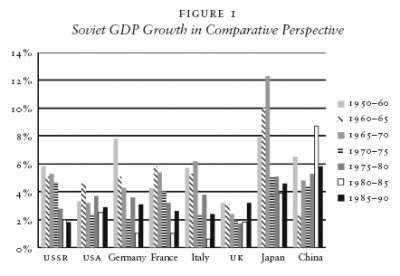
The transition to a market economy of market prices and private ownership began only after the Soviet flag was lowered over the Kremlin and replaced with the Russian flag on December 25, 1991. The hard work of creating a market economy remained ahead for Gorbachev’s successors in the 15 states that emerged from the ussr.
Economic growth
Ihave discussed the collapse of the Soviet administrative-command system without talking about the ussr’s worsening economic performance. Gorbachev himself listed “slowing economic growth” as his first concern upon gaining power: “In the last fifteen years the national income growth rates had declined by more than a half and by the beginning of the eighties had fallen to a level close to economic stagnation.”27If the decade-and-a-half experience with declining economic growth (with little hope of improvement ahead) made the continuation of the Soviet system untenable, it would have been only a matter of time before the system collapsed, irrespective of who was in charge. Gorbachev’s appearance on the scene only accelerated the inevitable collapse.
Figure 1 summarizes Soviet economic performance from the 1950 until Gorbachev’s appointment in 1985. It shows that the ussr began the postwar era with high rates of growth (which were matched by much of Europe and exceeded by the economic miracles in Germany and Japan). The rapid growth of the 1950s, however, promoted an air of economic superiority as Nikita Khrushchev boasted that the ussr would “bury” the West. Soviet growth declined steadily after 1970. In the five years preceding Gorbachev’s appointment, Soviet growth settled at 2 percent. A 2 percent growth rate was a bitter pill for a country seeking to compete on the world stage with the United States and Western Europe, but it was far from fatal.
The 1970s and early 1980s were also trying times in the West, as economic growth declined in response to two large energy shocks. Stagflation contributed to a huge sense of uncertainty throughout the globe. Asia looked better: Japan was recording what would be its last episode of relatively rapid economic growth, while China’s was experiencing the initial successes of its economic reforms begun in 1979 (China’s growth was almost 10 percent on the eve of Gorbachev’s appointment).
Figure 1 itself does not point to a Soviet economic crisis deep enough to justify scuttling the Soviet system. The period 1970–1985, however, offered ominous signs for the Soviet Union: Although the ussr was a beneficiary of the energy shocks of the 1970s and was still churning out high rates of capital formation, it was performing like its Western counterparts or slightly worse. Poor economic performance was at best a necessary but not sufficient condition for the revolution from above. If Soviet economic performance had been better, true, there would have been less interest in reform and less support for the outside option, but poor economic growth per se has little to say about the system’s viability.
The fact that reforms in China, begun in 1979, were starting to pay off with exceptional rates of growth may have had more to do with Gorbachev’s reform than comparisons with the West. Chinese reforms, which had been inspired by the rapid growth of Japan and of the Four Southeast Asian Tigers, suggested to Soviet leaders that their only hope of “catching up” was to do something new.
There was no outright collapse of the Soviet administrative command economy. It continued to have positive economic growth until its final two years, but, by that time, it had already been largely dismantled and the negative growth was a consequence of the collapse of the system, not a cause of the collapse.28
The Western academic and intelligence communities devoted a huge effort to projecting Soviet economic performance, none of which painted an optimistic picture. The overwhelming consensus, however, was that the Soviet Union would continue to “muddle along” on a “treadmill of reforms” without more than token tinkering with its basic economic and political institutions.
There was no clamoring from the population for change in the system. The majority of the population tacitly accepted the official tenets of Soviet socialism and appeared to prefer their way of life, although they were aware of the risks of dissidence. The higher consumption standards in the West were compensated by stability, free health care and education, and the like.29 Even Soviet immigrants in the United States reported being satisfied with their standard of living in the Soviet Union.30 Soviet citizens were moderately optimistic about the future, probably more so than their leaders. The powerful military-industrial complex, although it may have been concerned about falling behind the West, was an unlikely source of support for radical change. Insofar as military r&d and production tend to be state controlled irrespective of the economic system, I would doubt that military interests would lobby for capitalism.
Lessons learned
Twenty years ago, Mikhail Gorbachev, his academic advisors, and his rent-seeking accomplices destroyed the Soviet administrative-command economy. It was up to his successors in the 15 nations carved out of the ussr to decide what to do next. Some opted for transition (the Baltic states); others decided to keep as much of the old system as possible (Belarus and Uzbekistan). Most vacillated.
I have not addressed the interactions between the destruction of the administrative-command system and the political collapse of the Soviet Union. If we accept Marx’s principle that “productive forces” determine the “superstructure,” the end of the Soviet economic system would have had profound impacts on the Soviet political system and its infrastructure. But such impacts go beyond the scope of this essay.
The end of the Soviet administrative-command system constituted a paradigm shift. The world was forever changed. The fact that few saw it coming was the greatest intelligence failure of the twentieth century. This failure shows that scholars and intelligence communities are ill equipped to foresee paradigm shifts because they occur so rarely, and we cannot study their general tendencies. When they do happen we cannot prove hypotheses of their causes because we have no repetitions. Their rarity also suggests that paradigm shifts are not monocausal. They require a complex constellation of events. If they had one cause, they would be easy to see coming.
The collapse of the Soviet administrative-command economy required elite dissatisfaction with the current state of affairs; in this case, with declining economic growth. It required a rival embarking on what appeared to be a successful reform (China), and a Soviet leader willing and able to embark on radical experiments. That leader would also have to lack the insight of his predecessors that a logical outcome of this experimentation would be the destruction of the system itself. A reversal of incentives at the grass-roots level had to be engineered. A perverse economic system had to be established that offered economic rents to reconcile the two warring factions — producers and planners — and to enlist them as supporters of this endeavor. This explosive combination of ingredients ignited into a “perfect storm” that destroyed the administrative-command system that had held its own for half a century.
Does the unexpected collapse of the Soviet administrative-command system offer insights into the future of other dictatorships, such as in Syria, Iran, North Korea, or Cuba? In my view, we should avoid overemphasizing the economy. We believe that declining economic growth was only one factor in the collapse of the Soviet administrative-command system. Its primary role was to motivate the leadership to undertake risky schemes.
History shows that nondemocracies are generally characterized by poor economic performance,31 but they tend to be more stable than democracies.32 Economic success is more likely to create democracies than is economic failure.33 Poor economic performance may even enhance the stability of nondemocratic regimes by making the relative rents to regime supporters even more valuable.34 Rational dictators may even deliberately block modernization if ensuing change threatens to eliminate their political rents.35 Poorly managed and miserably performing dictatorships can have long lives — as North Korea, Cuba, and Africa show. Dictators can, in fact, retain power while running their economies into the ground as long as they can offer supporters sufficient rents, as the example of Robert Mugabwe in Zimbabwe illustrates.
Rather, in order to predict the end of a dictatorship, we must look for constellations of forces, many of which would not have played roles in the destruction of past dictatorships. The chances of success in this endeavor are limited, however, because we have so few observations.
1 Bruce Bueno de Mesquita et. al, The Logic of Political Survival (mit Press, 2005); Valery Lazarev, “Economics of One-Party Support: Promotion Incentives and Support for the Soviet Regime,” Comparative Economic Studies 47:2 (June 2005); Lazarev, “Political Labor Market, Government Policy and Stability of a Non-Democratic Regime,” Journal of Comparative Economics35:3 (September 2007); Daron Acemoglu and James Robinson, Economic Origins of Dictatorship and Democracy (Cambridge University Press, 2005).
2 Michael Ellman and Vladimir Kontorovich, The Destruction of the Soviet Economic System: An Insiders’ History (M.E. Sharpe, 1998), xxi–xxiv.
3 Oleg Khlevnyuk, “The People’s Commissariat of Heavy Industry”, in E.A. Rees, ed., Decision Making in the Stalinist Command Economy, 1932–37 (MacMillan, 1997), 109–11.
4 Quoted in Anders Åslund, Russia’s Capitalist Revolution: Why Market Reform Succeeded and Democracy Failed (Peterson Institute for International Affairs, 2007), 85.
5 Paul Gregory, The Political Economy of Stalinism (Cambridge, 2004), Chapter 4.
6 O.V. Khlevnyuk, R. Davies, L.P. Kosheleva, E.A. Ris, L.A. Rogovaia, Stalin i Kaganovich. Perepiski. 1931–1936 gg. (Moscow: Rosspen, 2001), 55.
7 Ellman and Kontorovich, Destruction of the Soviet Economic System, 46.
8 Quoted in O.V. Khlevniuk, Stalin i Ordzhonikidze: Koflikty v Politburo v 30-e Gody (Moscow: Izdatel’ski tsentr Rossia molodaia, 1993), 32.
9 Statement of deputy chairman of military industrial complex about the interference by the central committee, in Ellman and Kontorovich, Destruction of the Soviet Economic System, 47.
10 Mark Harrison, “Coercion, Compliance and the Collapse of the Soviet Command Economy,” Economic History Review 55 (2002).
11 Gertrude Schroder, “The Slowdown in Soviet Industry, 1976–1982,” Soviet Economy, 1:1 (January – March "smallcaps">1985<).
12 Ellman and Kontorvich, Destruction of the Soviet Economic System, 27
13 Lazarev, “Economics of One-Party Support.”
14 Åslund, Russia’s Capitalist Revolution,58–59.
15 Bueno de Mesquita et al., Logic of Political Survival.
16 Valery Boldin, Ten Years That Shook the World: The Gorbachev Era as Witnessed by his Chief of Staff (Basic Books, 1994), Chapters 2–3.
17 Ellman and Kontorovich, Destruction of the Soviet Economic System, Chapter 2; Boldin, Ten Years That Shook the World, Chapters 2–3.
18 Ellman and Kontorovich, Destruction of the Soviet Economic System, 22.
19 Ellman and Kontorovich, Destruction of the Soviet Economic System, 21.
20 Paul Gregory, “Bureaucrats, Managers and Perestroika: The First Five Years. Results of Surveys of Soviet Managers and Officials,” in nato, The Soviet Economy Under Gorbachev (Brussels: nato, 1991), 188–202.
21 Ellman and Kontorovich, Destruction of the Soviet Economic System, 18–19.
22 Boldin, Ten Years That Shook the World, 117.
23 Boldin, Ten Years That Shook the World, 158.
24 Åslund, Russia’s Capitalist Revolution, 38.
25 Gregory, Political Economy of Stalinism.
26 Gertrude Schroeder, “Recent Developments in Soviet Economic Planning and Managerial Incentives,” in Joint Economic Committee, Soviet Economic Prospects for the Seventies(Government Printing Office, 1973.
27 Mikhail Gorbachev, Perestroika: New Thinking for Our Country and the World (Harper and Row, 1987), 19.
28 Directorate of Intelligence, Handbook of Economic Statistics, 1991, cpas 91–10001 (September 1991), 37.
29 Vladimir Shlapentokh, “Standard of Living and Popular Discontent,” in Ellman and Kontorovich, 33–34.
30 James Millar, Politics, Work, and Daily Life in the USSR (Cambridge, 1987), 33.
31 Robert Barro, “Determinants of Democracy,” Journal of Political Economy 107 (1999).
32 Bueno de Mesquita et al., Logic of Political Survival.
33 Y. Feng and P. Zak, “The Determinants of Democratic Transitions,” Journal of Conflict Resolution 43 (1999).
34 Bueno de Mesquita et al., Logic of Political Survival; Valery Lazarev, “Political Labor Market, Government Policy and Stability of a Non-Democratic Regime,” Journal of Comparative Economics 35:3 (September 2007).
35 Acemoglu and Robinson, Economic Origins of Dictatorship and Democracy.







